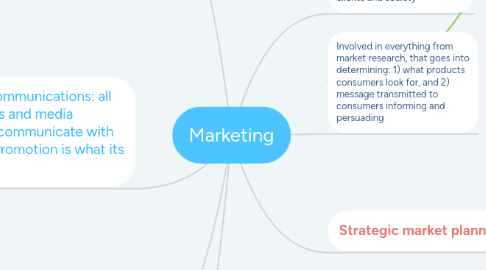Marketing
저자: Esha egogri7


1. Marketing Mix
1.1. Product: product (tangible)/ service (intangible, perishable, inseparable, variable) fulfilling customer needs. Perception is key.
1.2. Place: distribution from production to consumption. the location and time (distribution channels are retail and physical)
1.3. Price: what customers pay and businesses earn as revenue (gauge for product quality)
1.3.1. Strategies as price penetration (AT&T), skimming (Apple), high-low (JC Penny) and EDLP (Tesco)
1.3.2. Objectives are building profitability, boost volume (sales or market share increase using strategies), matching competition (grocery goods) and pricing for prestige (skimming- Apple)
1.4. Promotion: materials used to communicate about the product
1.4.1. Mix is advertising, personal selling (Hermes), sales promotion (Tesco coupons) and PR (BP deep water horizon or Taco Bell meat issues)
2. Marketing Communications: all the messages and media deployed to communicate with the market. Promotion is what its all about
2.1. Communication process of 7 elements (it shows which investments reap the greatest benefits)
2.2. Five steps are 1) Identify target audience (Merc), 2) Determine communication objectives (PLC stages differ), 3) Design message (environmental factors influence), 4) Make budget decisions (regarding promotional mis) and 5) Consider communication tools (promotional mix)
2.3. Effective MarCom = where marketing and promotional activities attract a huge portion of long run customers
3. Consumer purchase behaviour (attitudes)
3.1. 1) Cognition- the knowing component, the belief or knowledge of a product
3.2. 2) Affect- the feeling component, overall emotional component of a product (dominant for expensive products)
3.3. 3) Behaviour- the doing component, involves consumer intention to do (purchase)
4. Consumer buying process
4.1. 1) Problem/ need recognition
4.2. 2) Information seek
4.3. 3) Evaluation of alternatives
4.4. 4) Purchase decision
4.5. 5) Post purchase behaviour (cognitive dissonance)
5. Creating, communicating and delivering value to consumers, clients and society
6. Involved in everything from market research, that goes into determining: 1) what products consumers look for, and 2) message transmitted to consumers informing and persuading
7. Strategic market planning
7.1. Answers 1) what we sell, 2) whom do we sell to (these determine business focus) and 3) how we beat competition (strategies to market)
7.1.1. 1) Identify objectives and determine mission
7.1.2. 2) Situational analysis of in/ex environments
7.1.3. 3) Devise a strategy (SWOT, marketing, budget, price, distribution)
7.1.4. 4) Implement strategy
7.1.5. 5) Evaluate and modify

